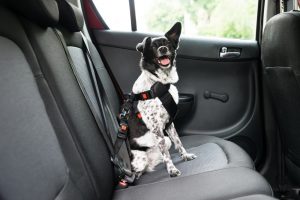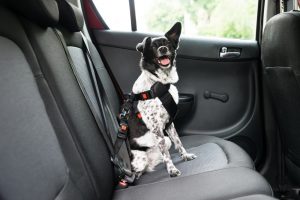
Every time you get in the car, it’s probably second nature to check the mirrors, press play on your driving playlist, and, of course, put on your seatbelt. But what about your canine copilot? Do they need a dog seat belt to drive safely with you?
No matter if you’re driving your pooch to their caring Pet Sitter’s home or starting an epic road trip, it’s always a good idea to keep your pup safe and secure while you drive. In this article, we’ll cover all your questions about how to make sure that Fido is clicked in and ready to go!
What are the dog seat belt laws in Australia?
Though you might not have been tested on them during your Driver Knowledge Test, there are specific laws on the books about car safety for pets. Each state is slightly different, but most require the dog to be away from the driver. Some states, like NSW, will issue fines for unrestrained dogs inside the car or in the back of a ute.
As you might have guessed, these laws are as much about animal welfare as they are about driver safety. Doggos who are excited, nervous, or simply inexperienced in the car are at risk for injury or jumping or falling out of open windows. Having your dog unrestrained in your car also poses a risk to your ability to focus while potentially distracting other drivers on the road.
So, even if the laws in your state are less restrictive than others, it’s a good idea to find the right way to keep your pup as safe as possible on the road.
Are there different kinds of seat belts for dogs?
In general, you’ll find three main types of dog seat belt options on the market:
- Seat belt attachment. A seat belt attachment is one of the most popular models for Dog Owners and features a short leash that attaches your dog’s harness or collar to the seat belt receptacle, seat belt strap, or car seat. This style is best suited for dogs who may be overly active in the car or suffer from motion sickness, as the dog seat belt tends to keep them in place and facing forward
- Pet basket. Pet baskets are designed for small dogs who will feel more comfortable in a cozy little travel bed. Many feature a booster seat so that your small dog can more comfortably look out of the window while sitting down
- Zipline runner. This dog leash contains two parts—a leash and a zipline—to give your dog freedom to move in the back of the car. The ends of the zipline attach to the interior of the car so that the leash can slide back and forth as your dog moves. If your dog has a tendency to want to look at the sights on both sides of the car, a zipline dog seat belt is the way to go
Should a seat belt be attached to a dog’s collar or harness?
Many of the dog seat belts you can buy are fitted with a simple clasp or carabiner that can attach to a harness or collar. So, you might wonder how to leash up your pup to their seat belt.
Overall, the choice is up to you. But, most dog experts recommend attaching the dog seat belt to a secure harness. In the case that you need to suddenly stop the car, or your pup has a tendency to try lunging out of the car as you open the door, a harness comes with a lower risk of neck injury.
If your dog doesn’t normally wear a harness, and you want to buy one for the road, look for models that have been crash tested.
Is a dog seat belt better than a crate?
Australian law doesn’t specify whether you should restrain your dog with a dog seat belt or crate, so ultimately, you can choose!
If you’ve worked on crate training at home, a car carrier may be the most comfortable option for your pooch. You can also find many travel crates that have been crash tested to ensure maximum safety for your dog.
If your dog tends to experience anxiety in a crate or in the car, a seat belt may be a better option. Seat belts give dogs the ability to see their surroundings and their beloved humans, which will help them to feel more settled on the road.
No matter which option you choose, there are a few key steps you should take to make your pup feel better about every road trip.
How should you introduce your dog to a dog seat belt?
Whether your dog is a pro at loose leash walking or they live their life mostly leash-free, you’ll still want to introduce them to a dog seat belt slowly. After all, being in a moving vehicle is a unique environment that can mean excitement, anxiety, motion sickness, or a range of other emotions for your dog. And, you don’t want to make the situation worse by restraining them before they’re ready.
Here are a few tips to get your dog road trip ready:
- Introduce all driving equipment inside the home. It’s always best to introduce new collars, harnesses, and in this case, dog seat belts when your dog is in a familiar environment. Over the course of a few days or weeks, your goal will be to help your dog see their driving gear as a good thing! They should be able to wear it comfortably around the house (or in the case of a driving crate, spend time inside) before moving onto the next step. Some dogs will be fine wearing their dog seat belt from the start; others will take time and treats to come around
- Load up, but don’t go anywhere just yet. It’s one thing for your pup to wear their driving gear at home, and quite another to wear it in the car. Especially if it took a while to get your dog comfortable with their dog seat belt or harness at home, you’ll want to spend extra time introducing them to the equipment in the car. And, because you want to be able to give your dog plenty of treats and verbal praise to promote calm behaviour, don’t start driving until you’re sure that your dog is ready
- Try out short trips, after some exercise. When you are ready to test out your dog’s tolerance to driving with their dog seat belt, set them up for success by exercising them beforehand, and keeping your trips short. If you’re picking your pooch up from their Pet Sitter, for example, you might request that they have a play session or walk with your dog before you arrive. And if your pup is really struggling with feeling restrained in the car, you might only take trips around the block and rely on a helper to drive while you comfort your dog
- Review our other tips for keeping your dog safe in the car. Safely restraining your furry friend in the car is just one way to ensure a successful road trip! Take a look at our other tips for preparing your pup to be a happy canine copilot!
Final thoughts on using a dog seat belt
Overall, you want to choose the restraint option that is safest and most comfortable for your unique doggo. Whether you opt for a doggy zipline, dog seat belt harness, small dog basket, or cozy carrier, once your dog is clicked in, you can hit the road with peace of mind!
